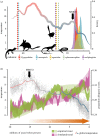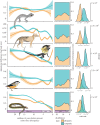Miocene biome turnover drove conservative body size evolution across Australian vertebrates
- PMID: 30333208
- PMCID: PMC6234893
- DOI: 10.1098/rspb.2018.1474
Miocene biome turnover drove conservative body size evolution across Australian vertebrates
Abstract
On deep time scales, changing climatic trends can have a predictable influence on macroevolution. From evidence of mass extinctions, we know that rapid climatic oscillations can indirectly open niche space and precipitate adaptive radiation, changing the course of ecological diversification. These dramatic shifts in the global climate, however, are rare events relative to extended periods of protracted climate change and biome turnover. It remains unclear whether during gradually changing periods, shifting habitats may instead promote non-adaptive speciation by facilitating allopatry and phenotypic conservatism. Using fossil-calibrated, species-level phylogenies for five Australian radiations comprising more than 800 species, we investigated temporal trends in biogeography and body size evolution. Here, we demonstrate that gradual Miocene cooling and aridification correlates with the restricted phenotypic diversification of multiple ecologically diverse vertebrate groups. This probably occurred as species ranges became fractured and isolated during continental biome restructuring, encouraging a shift towards conservatism in body size evolution. Our results provide further evidence that abiotic changes, not only biotic interactions, may act as selective forces influencing phenotypic macroevolution.
Keywords: adaptive radiation; comparative methods; macroevolution; marsupials; phenotypic evolution; reptiles.
© 2018 The Author(s).
Conflict of interest statement
We declare we have no competing interests.
Figures



Similar articles
-
Mass turnover and recovery dynamics of a diverse Australian continental radiation.Evolution. 2017 May;71(5):1352-1365. doi: 10.1111/evo.13207. Epub 2017 Mar 11. Evolution. 2017. PMID: 28213971
-
What defines an adaptive radiation? Macroevolutionary diversification dynamics of an exceptionally species-rich continental lizard radiation.BMC Evol Biol. 2015 Aug 7;15:153. doi: 10.1186/s12862-015-0435-9. BMC Evol Biol. 2015. PMID: 26245280 Free PMC article.
-
Lineage Diversity and Size Disparity in Musteloidea: Testing Patterns of Adaptive Radiation Using Molecular and Fossil-Based Methods.Syst Biol. 2018 Jan 1;67(1):127-144. doi: 10.1093/sysbio/syx047. Syst Biol. 2018. PMID: 28472434
-
Birth of a biome: insights into the assembly and maintenance of the Australian arid zone biota.Mol Ecol. 2008 Oct;17(20):4398-417. doi: 10.1111/j.1365-294X.2008.03899.x. Epub 2008 Aug 27. Mol Ecol. 2008. PMID: 18761619 Review.
-
Why does diversification slow down?Trends Ecol Evol. 2014 Apr;29(4):190-7. doi: 10.1016/j.tree.2014.01.010. Epub 2014 Mar 5. Trends Ecol Evol. 2014. PMID: 24612774 Review.
Cited by
-
Geographic range size and speciation in honeyeaters.BMC Ecol Evol. 2022 Jun 29;22(1):86. doi: 10.1186/s12862-022-02041-6. BMC Ecol Evol. 2022. PMID: 35768772 Free PMC article.
-
Digital dissection of the head of the rock dove (Columba livia) using contrast-enhanced computed tomography.Zoological Lett. 2019 Jun 10;5:17. doi: 10.1186/s40851-019-0129-z. eCollection 2019. Zoological Lett. 2019. PMID: 31205748 Free PMC article.
-
Habitat openness and squamate color evolution over deep time.Nat Commun. 2025 Mar 17;16(1):2625. doi: 10.1038/s41467-025-57547-6. Nat Commun. 2025. PMID: 40097397 Free PMC article.
References
-
- Cramer BS, Miller KG, Barrett PJ, Wright JD. 2011. Late Cretaceous–Neogene trends in deep ocean temperature and continental ice volume: reconciling records of benthic foraminiferal geochemistry (δ18O and Mg/Ca) with sea level history. J. Geophys. Res. Oceans 116, 1–23. (10.1029/2011JC007255) - DOI
Publication types
MeSH terms
Associated data
LinkOut - more resources
Full Text Sources

